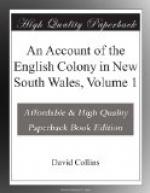Cole-be’s wife, the namesake of the Ba-rang-a-roo I have just mentioned, did not survive her many months. She died of a consumption, brought on by suckling a little girl who was at her breast when she died. This circumstance led to the knowledge of a curious but horrid custom which obtains among these people. The mother died in the town, and when she was taken to the grave her corpse was carried to the door of every hut and house she had been accustomed to enter during the latter days of her illness, the bearers presenting her with the same ceremonies as were used at the funeral of Ba-loo-der-ry, when the little girl Dil-boong and the boy Be-dia were placed before his corpse.
When the body was placed in the grave, the bye-standers were amazed to see the father himself place the living child in it with the mother. Having laid the child down, he threw upon it a large stone, and the grave was instantly filled in by the other natives. The whole business was so momentary, that our people had not time or presence of mind sufficient to prevent it; and on speaking about it to Cole-be, be, so far from thinking it inhuman, justified the extraordinary act by assuring us that as no woman could be found to nurse the child it must die a much worse death than that to which he had put it. As a similar circumstance occurred a short time after, we have every reason to suppose the custom always prevails among them; and this may in some degree account for the thinness of population which has been observed among the natives of the country.*
[* Cole-be’s child was about four or five months old, and seemed to have partaken of its mother’s illness. I think it could not have lived.]
I have said that these women were namesakes. Bennillong’s wife was called Ba-rang-a-roo Daring-ha; Cole-be’s, Daring-ha Ba-rang-a-roo. A peculiarity in their language occurs to me in this place. The males of the same name call each other Da-me-li, the women call each other Da-me-li-ghen.
I have mentioned their taking particular names on certain occasions. The mutual friend who attends them to the field is styled Ca-bah-my; the persons who at their funerals are painted red and white, are named Moo-by; the namesake of a deceased person, if a male, is styled Bo-rahng; if a woman, Bo-rahn-gal-le-on. When Nor-roo-ing came into the town to acquaint us with the death of Yel-lo-way, she was perfectly a dismal sorrowing figure. She had covered herself entirely with ashes, was named while she continued so Go-lahng, and refused all kinds of sustenance.
The annexed Plate represents the burning of the corpse of a native who was killed by a limb of a tree falling on him. He was brought to the spot with all the preceding ceremonies. His head was laid to the northward, and in his hands were deposited his spear and his throwing-stick. His ashes were afterwards raked together, and a tumulus erected over them, similar to that which Bennillong had raised over his wife.




